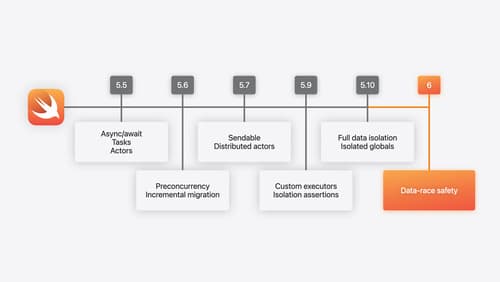How do I build a client-server application using QUIC?
Asked on 2024-07-30
1 search
To build a client-server application using QUIC, you can leverage the Swift on Server ecosystem, which provides various tools and libraries to facilitate server-side development. Here are the steps and relevant sessions from WWDC that can guide you through the process:
-
Introduction to Swift on Server:
- Swift is a great language for developing server applications due to its performance, memory safety, and concurrency features. It is used extensively within Apple's cloud services and is suitable for modern cloud services requiring predictable resource consumption and fast startup times.
- Explore the Swift on Server ecosystem
-
Concurrency in Swift:
- Understanding concurrency in Swift is crucial for handling multiple client requests efficiently. Swift's concurrency model, based on tasks, allows you to write scalable and responsive server applications.
- A Swift Tour: Explore Swift’s features and design
-
Building a Service:
- You can start by building a simple service using popular packages from the Swift on Server ecosystem. For example, you can use Vapor, a popular web framework for Swift, to handle HTTP requests and responses.
- Explore the Swift on Server ecosystem
-
Database Integration:
- Integrate your service with a database to persist data. There are many database drivers available, such as Postgres, MySQL, and MongoDB. For instance, you can use the Postgres Neo driver for asynchronous database operations.
- Explore the Swift on Server ecosystem
-
Cross Compilation:
- To deploy your service on a Linux server, you can cross-compile your Swift application. This involves building the application on macOS and then running it on a Linux environment.
- What’s new in Swift
-
Exploring the Ecosystem:
- Explore additional libraries and tools in the Swift on Server ecosystem for networking, observability, and more. This can help you find the right packages to implement QUIC in your application.
- Explore the Swift on Server ecosystem
By following these steps and utilizing the resources provided in the sessions, you can build a robust client-server application using Swift and integrate QUIC for efficient and secure communication. If you need more specific details on implementing QUIC, you might need to look into additional resources or specific libraries that support QUIC in the Swift ecosystem.

Explore the Swift on Server ecosystem
Swift is a great language for writing your server applications, and powers critical services across Apple’s cloud products. We’ll explore tooling, delve into the Swift server package ecosystem, and demonstrate how to interact with databases and add observability to applications.

A Swift Tour: Explore Swift’s features and design
Learn the essential features and design philosophy of the Swift programming language. We’ll explore how to model data, handle errors, use protocols, write concurrent code, and more while building up a Swift package that has a library, an HTTP server, and a command line client. Whether you’re just beginning your Swift journey or have been with us from the start, this talk will help you get the most out of the language.

What’s new in Swift
Join us for an update on Swift. We’ll briefly go through a history of Swift over the past decade, and show you how the community has grown through workgroups, expanded the package ecosystem, and increased platform support. We’ll introduce you to a new language mode that achieves data-race safety by default, and a language subset that lets you run Swift on highly constrained systems. We’ll also explore some language updates including noncopyable types, typed throws, and improved C++ interoperability.
